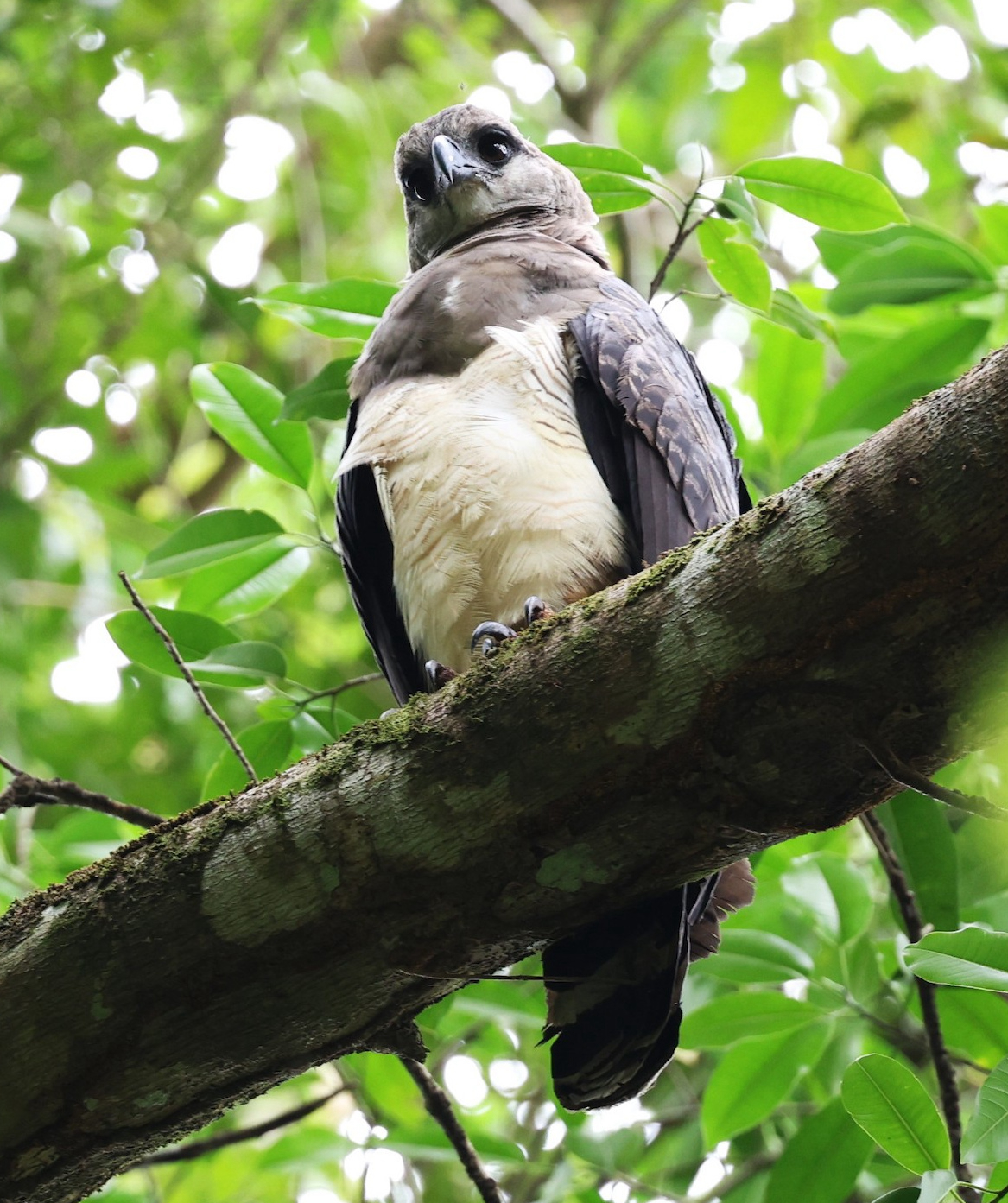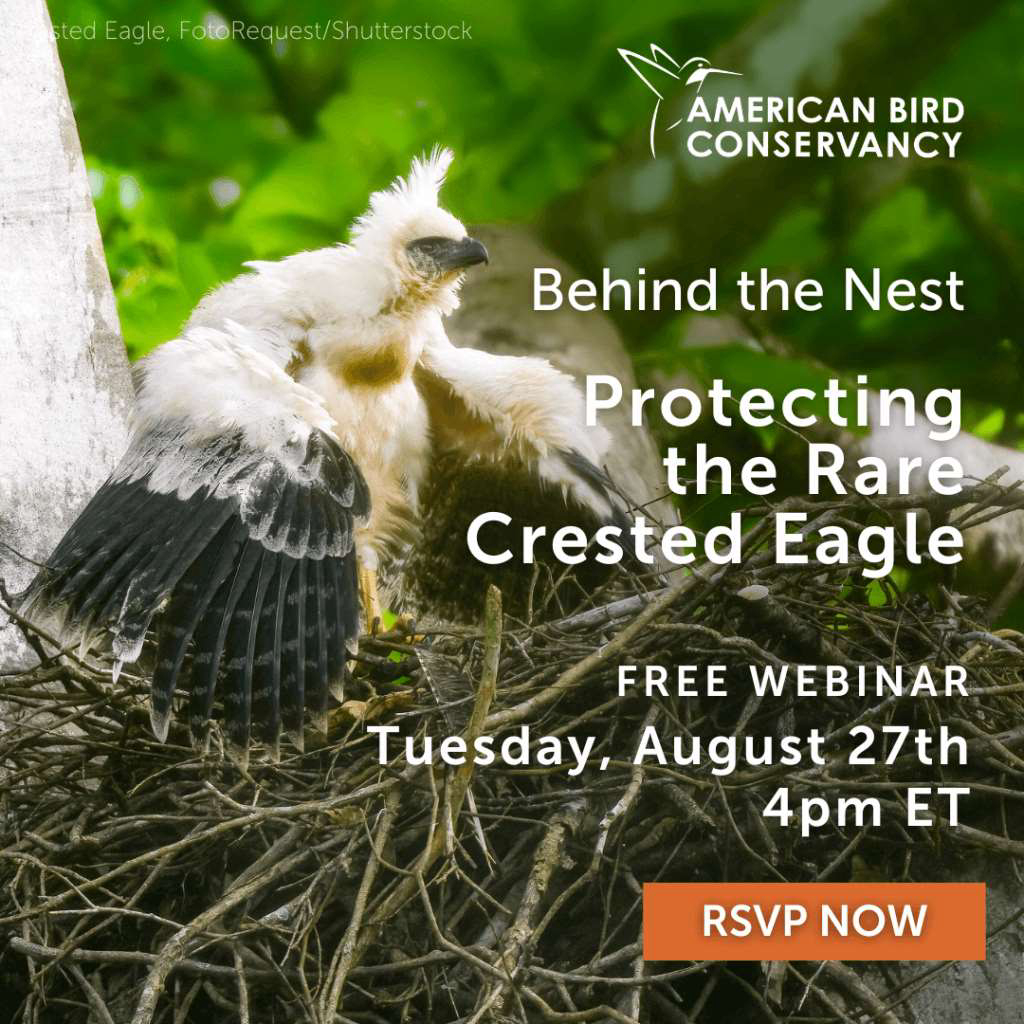
When viewing the live cam located in southeast Peru, the bird you will see most often in the nest is the young Crested Eagle, which is mostly white in color and about 4 months old now. You may also see an adult delivering food to the nest or resting on the large nest near the feathered nestling (adult Crested Eagle photo by Alexander Alvarado).

|
In the heart of the Peru’s rainforest, along a remote tributary of the Amazon, a pair of Crested Eagles are raising a stunning nestling that’s now about 4 months old and fully feathered. And now you can view the action at their nest, now live streaming online. Through the efforts of the American Bird Conservancy (ABC) and Rainforest Expeditions, you are invited to a virtual front-row seat showcasing the daily activities of one of the rarest and most secretive raptors in the world, the Crested Eagle.
“When our partners at Rainforest Expeditions told us about the Crested Eagle nest on their property in Peru, we couldn’t resist the opportunity to share the good news and observe the lives of these mysterious birds with everyone,” said Daniel Lebbin, ABC’s Vice President of Threatened Species. “ABC has been working with local partners to establish a 656-acre reserve for Crested Eagles in Alto Sinu, Colombia, but much is still unknown about their behavior and activities. We are excited to offer live cam viewers a unique glimpse into these rare raptors, while also learning more about this species.”
In May, Rainforest Expeditions’ birding guide, Fernando Ccoa, noticed unusual bird activity during a conservation monitoring trip with local field researchers in a remote part of the Tambopata National Reserve. Upon closer inspection, he was thrilled to find the active nest of a rare Crested Eagle, only 30 minutes away from the Refugio Amazonas Lodge where he works, adjacent to the Tambopata National Reserve.
“When I discovered the nest, the nestling was not yet visible, leaving us unsure if there was an egg and if it had just been laid,” said Ccoa. “These birds are incredibly beautiful, and now that they have found a safe haven in our surroundings, it is our duty to protect them.”
Given the fragility of the species, every precaution was taken to avoid disturbing the active adults and newly hatched nestling. After outlining the requirements for safe observations, Ccoa and local field researchers Aracely Meza and Gabriel Serrano established a strict protocol to ensure the safety and well-being of the rare eagles. To allow visitors to enjoy the experience without disturbing the eagles, a viewing blind was installed a safe distance from the nest. Later, the nest cam was carefully installed that streamed live inside the Refugio Amazonas Lodge, offering lodge visitors an extraordinarily intimate eagle experience. Now, in partnership with ABC, Rainforest Expeditions has made it possible for anyone to observe these magnificent rainforest eagles at American Bird Conservancy Exclusive: Crested Eagle Nest (abcbirds.org)
“The Peruvian Amazon is renowned for its incredible biodiversity and stunning natural beauty. When I arrived in Tambopata, I had a dream to protect this amazing region through scientific research and ecotourism,” said Eduardo Nycander, founder of Rainforest Expeditions. “Refugio Amazonas Lodge embodies that dream, promoting ecotourism and conservation efforts at every turn. By participating in this unique birding activity, you are not only immersing yourself in an extraordinary wildlife experience but also becoming a crucial part of our mission. Your involvement supports vital conservation efforts that are essential for the recovery and preservation of the Amazon rainforest and the countless species that live there.”
Visitors come from around the world to observe the diverse birdlife and experience the rainforest at reserves managed by Rainforest Expeditions and other ABC partners. ABC supports reserves with ecolodges in some of the most biodiverse places in the Americas, with an emphasis on protecting habitat for endangered species such as Indigo Macaws in Brazil, the El Oro Parakeets in Ecuador, and Blue-throated Macaws in Bolivia. Visitor fees help to ensure the sustainability of these protected areas and provide income for local people. For 30 years, ABC and its partners have helped protect more than a million acres of land in more than 100 reserves in 15 countries.
About Crested Eagles
Crested Eagles are among the most impressive raptors in the world, but they are also among the least known of the large rainforest eagles. Known for their powerful build, distinctive crest, and long tail, Crested Eagles feed on a variety of forest animals, ranging from tree-dwelling mammals including smaller monkeys, opossums, and kinkajous; larger birds such as guans and curassows, and even large snakes and lizards. Stealthy hunters, a Crested Eagle will often perch quietly for long periods before surprising its prey with a quick aerial strike.
Solitary in nature, Crested Eagles are only seen in pairs during the nesting season, when a mated pair builds a bulky stick nest in the crotch of a tree positioned high in the forest canopy. The female lays 1 or 2 eggs, which she incubates while her mate supplies food for her; however, only one nestling has ever been observed in a Crested Eagle nest. Young fledge 3 to 4 months after hatching, and even after leaving the nest, the fledgling centers its activities around the nest while it is dependent on the adult pair for food. The post-fledging period for a young Crested Eagle is extensive while it learns to fly and hunt for prey itself, and may remain dependent on the adults for up to 1½ years before attaining full independence. Due to this extended maturation rate, pairs of Crested Eagles only nest once every 2 to 3 years when they successfully raise a juvenile eagle to independence.
Crested Eagles have an extensive Latin American range, but sparse distribution within the area from southern Mexico south to Colombia, east to French Guiana, and south to southern Brazil, eastern Peru, and central Bolivia. It requires large areas of lowland tropical or subtropical forests with large healthy trees. The presence of a Crested Eagle is considered a strong indicator of a healthy and thriving ecosystem, especially if there is nesting activity.
Free Crested Eagle Webinar
Join American Bird Conservancy on Tuesday, August 27 at 4:00 EDT for a Free webinar to learn more about the nest cam observations as well as conservation efforts for the species, including ABC's work with local partners to conserve Crested Eagles and other vulnerable birds that share tropical forest habitats.
You will get an insider’s look at the Crested Eagles at their nest in southeast Peru, made possible by ABC’s partnership with Rainforest Expeditions. You will also learn about a new reserve in Colombia that is protecting that country’s first known Crested Eagle nestling. The reserve was established by Sociedad Ornitologica de Cordoba with support from the direct investment funds of the Conserva Aves initiative and other generous ABC donors. You can register for the webinar now at RSVP now » and if you can’t attend the live webinar, you can register for a recording of the webinar that will be sent to you so can watch anytime it’s convenient – refer to RSVP and we'll send you a recording to enjoy when the time is right for you!
For more information and photographs, you can refer to the ABC’s article at Nature Fans Invited to Tune In to First-ever Crested Eagle Nest Webcam - American Bird Conservancy (abcbirds.org) and you can also learn more about Crested Eagles at the ABC species profile webpage at Crested Eagle - American Bird Conservancy (abcbirds.org)